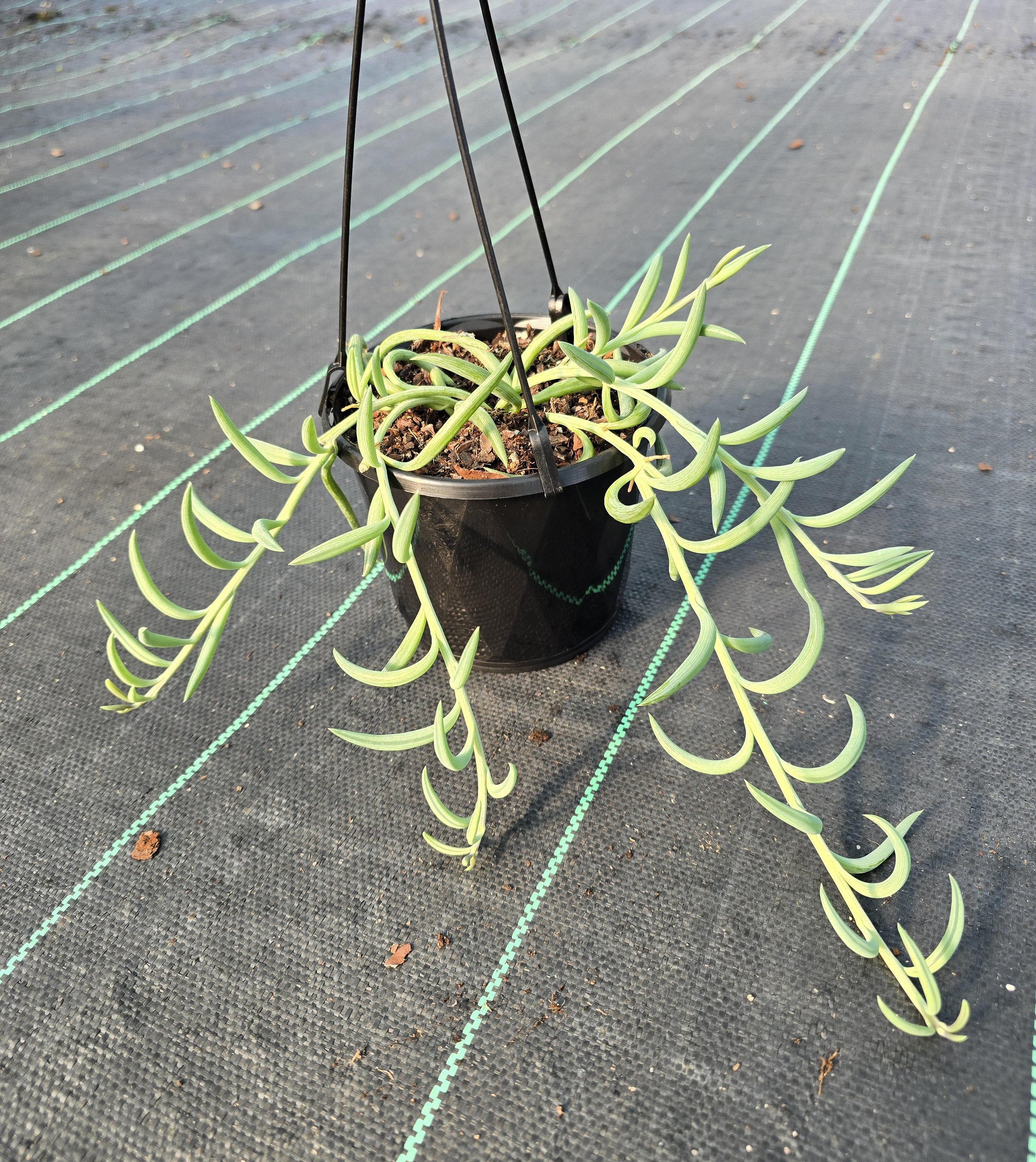 Image 1 of 1
Image 1 of 1


String of Bananas
🌿 String of Bananas (Senecio radicans / Curio radicans)
Common Names:
String of Bananas, Banana Vine, Fishhook Senecio
Family:
Asteraceae (Daisy family)
Native Range:
South Africa
📏 Physical Description
Growth Habit:
A fast-growing, trailing succulent with cascading stems that can reach up to 1 meter (3 feet) or more in length when mature.Leaves:
Its most distinctive feature is its banana-shaped leaves:
Long, curved, plump, and glossy green, resembling small bananas strung along the vine.
Each leaf also has a subtle translucent window (a line running along the leaf) which helps the plant photosynthesize in lower light.Stems:
Thin, green trailing stems that root easily where they touch soil.
🌸 Flowers
Bloom Time:
Usually late winter to early spring, though can flower sporadically indoors.Flower Appearance:
Small, white, cinnamon-scented flowers, not especially showy, but pleasantly fragrant.
🌱 Care and Cultivation
Light:
Prefers bright indirect light or filtered sun.
Can tolerate some direct morning sun, but harsh afternoon sun may scorch it.Watering:
Water deeply but infrequently.
Allow soil to fully dry out between waterings to prevent root rot.
More drought-tolerant than overwatering-tolerant.Soil:
Needs well-draining, sandy or cactus/succulent soil mix.Temperature:
Thrives in temperatures between 18–24°C (65–75°F).
Not frost-tolerant. Bring indoors if temperatures drop below 5°C (41°F).Humidity:
Prefers low humidity, as it’s adapted to arid conditions.Feeding:
Fertilize with a diluted cactus fertilizer every 4–6 weeks during the growing season (spring and summer).Propagation:
Extremely easy from stem cuttings. Simply snip a piece, let it callous for a day, then place on soil.
✅ Common Uses
Perfect for hanging baskets, wall planters, shelf displays, and indoor trailing greenery.
Can be grown outdoors in xeriscapes or rock gardens in frost-free climates.
✅ Potential Issues
Root Rot: Caused by overwatering or poorly draining soil.
Pests: Occasionally susceptible to mealybugs, spider mites, or aphids.
Legginess: If grown in too little light, it may become sparse and stretched.
✅ Quick Care Summary
RequirementDetailsLightBright, indirect lightWaterLet soil dry completelySoilWell-draining succulent mixTemperatureKeep above 5°C (41°F)PropagationSuper easy from cuttings
🌿 String of Bananas (Senecio radicans / Curio radicans)
Common Names:
String of Bananas, Banana Vine, Fishhook Senecio
Family:
Asteraceae (Daisy family)
Native Range:
South Africa
📏 Physical Description
Growth Habit:
A fast-growing, trailing succulent with cascading stems that can reach up to 1 meter (3 feet) or more in length when mature.Leaves:
Its most distinctive feature is its banana-shaped leaves:
Long, curved, plump, and glossy green, resembling small bananas strung along the vine.
Each leaf also has a subtle translucent window (a line running along the leaf) which helps the plant photosynthesize in lower light.Stems:
Thin, green trailing stems that root easily where they touch soil.
🌸 Flowers
Bloom Time:
Usually late winter to early spring, though can flower sporadically indoors.Flower Appearance:
Small, white, cinnamon-scented flowers, not especially showy, but pleasantly fragrant.
🌱 Care and Cultivation
Light:
Prefers bright indirect light or filtered sun.
Can tolerate some direct morning sun, but harsh afternoon sun may scorch it.Watering:
Water deeply but infrequently.
Allow soil to fully dry out between waterings to prevent root rot.
More drought-tolerant than overwatering-tolerant.Soil:
Needs well-draining, sandy or cactus/succulent soil mix.Temperature:
Thrives in temperatures between 18–24°C (65–75°F).
Not frost-tolerant. Bring indoors if temperatures drop below 5°C (41°F).Humidity:
Prefers low humidity, as it’s adapted to arid conditions.Feeding:
Fertilize with a diluted cactus fertilizer every 4–6 weeks during the growing season (spring and summer).Propagation:
Extremely easy from stem cuttings. Simply snip a piece, let it callous for a day, then place on soil.
✅ Common Uses
Perfect for hanging baskets, wall planters, shelf displays, and indoor trailing greenery.
Can be grown outdoors in xeriscapes or rock gardens in frost-free climates.
✅ Potential Issues
Root Rot: Caused by overwatering or poorly draining soil.
Pests: Occasionally susceptible to mealybugs, spider mites, or aphids.
Legginess: If grown in too little light, it may become sparse and stretched.
✅ Quick Care Summary
RequirementDetailsLightBright, indirect lightWaterLet soil dry completelySoilWell-draining succulent mixTemperatureKeep above 5°C (41°F)PropagationSuper easy from cuttings